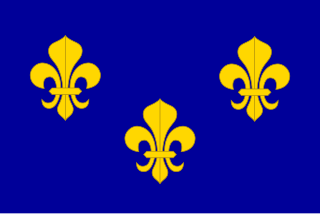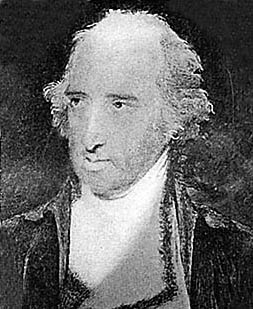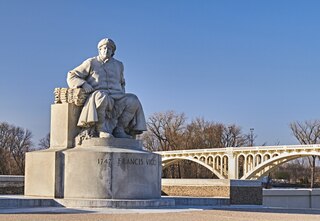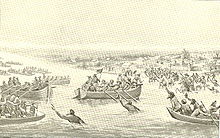
Vincennes is a city in, and the county seat of, Knox County, Indiana, United States. It is located on the lower Wabash River in the southwestern part of the state, nearly halfway between Evansville and Terre Haute. It was founded in 1732 by French fur traders, including the namesake François-Marie Bissot, Sieur de Vincennes. It is the oldest continually inhabited European settlement in Indiana and was its longest serving territorial capital. It is one of the oldest settlements west of the Appalachians. The population was 16,759 at the 2020 census.

The Illinois Country — sometimes referred to as Upper Louisiana —was a vast region of New France claimed in the 1600s in what is now the Midwestern United States. While those names generally referred to the entire Upper Mississippi River watershed, French colonial settlement was concentrated along the Mississippi and Illinois Rivers in what is now the U.S. states of Illinois and Missouri, with outposts on the Wabash River in Indiana. Explored in 1673 from Green Bay to the Arkansas River by the Canadien expedition of Louis Jolliet and Jacques Marquette, the area was claimed by France. It was settled primarily from the Pays d'en Haut in the context of the fur trade, and in the establishment of missions from Canada by French Catholic religious orders. Over time, the fur trade took some French to the far reaches of the Rocky Mountains, especially along the branches of the broad Missouri River valley. The French name, Pays des Ilinois, means "Land of the Illinois [plural]" and is a reference to the Illinois Confederation, a group of related Algonquian native peoples.

The Illinois campaign, also known as Clark's Northwestern campaign, was a series of engagements during the American Revolutionary War in which a small force of Virginia militia led by George Rogers Clark seized control of several British posts in the Illinois Country of the Province of Quebec, located in modern-day Illinois and Indiana in the Midwestern United States. The campaign is the best-known action of the western theater of the war and the source of Clark's reputation as an early American military hero.

George Rogers Clark was an American military officer and surveyor from Virginia who became the highest-ranking Patriot military officer on the northwestern frontier during the Revolutionary War. He served as leader of the Virginia militia in Kentucky throughout much of the war. He is best known for his captures of Kaskaskia in 1778 and Vincennes in 1779 during the Illinois campaign, which greatly weakened British influence in the Northwest Territory and earned Clark the nickname of "Conqueror of the Old Northwest". The British ceded the entire Northwest Territory to the United States in the 1783 Treaty of Paris.

Henry Hamilton was an Anglo-Irish military officer and later government official of the British Empire. He served in North America as Lieutenant Governor of the Province of Quebec and later as Deputy Governor after the American Revolutionary War. He later served as Governor of Bermuda and lastly, as Governor of Dominica, where he died in office.

Fort Ouiatenon, built in 1717, was the first fortified European settlement in what is now Indiana, United States. It was a palisade stockade with log blockhouse used as a French trading post on the Wabash River located approximately three miles southwest of modern-day West Lafayette. The name 'Ouiatenon' is a French rendering of the name in the Wea language, waayaahtanonki, meaning 'place of the whirlpool'. It was one of three French forts built during the 18th century in what was then New France, later the Northwest Territory and today the state of Indiana, the other two being Fort Miami and Fort Vincennes. A substantial French settlement grew up around the fort in the mid-18th century. It was ceded to the British and abandoned after the French and Indian War. Later, it passed into Indian hands and was destroyed in 1791 by American militia during the Northwest Indian War. It was never a U.S. fort. The original site was rediscovered in the 1960s; the archaeological site was listed on the National Register of Historic Places in 1970, and was designated a National Historic Landmark in 2021.

George Rogers Clark National Historical Park, located in Vincennes, Indiana, on the banks of the Wabash River at what is believed to be the site of Fort Sackville, is a United States National Historical Park. President Calvin Coolidge authorized a classical memorial and President Franklin D. Roosevelt dedicated the completed structure in 1936.

Francis Vigo, born Giuseppe Maria Francesco Vigo, was an Italian-American who aided the American colonial forces during the Revolutionary War and helped found a public university in Vincennes, Indiana.

During the 18th and early 19th centuries, the French, British and U.S. forces built and occupied a number of forts at Vincennes, Indiana. These outposts commanded a strategic position on the Wabash River. The names of the installations were changed by the various ruling parties, and the forts were considered strategic in the French and Indian War, the American Revolutionary War, the Northwest Indian War and the War of 1812. The last fort was abandoned in 1816.

Augustin Mottin de La Balme was a French cavalry officer who served in Europe during the Seven Years' War and in the United States during the American Revolution. His attempt to capture Fort Detroit in 1780 ended in defeat when he was ambushed by forces under Chief Little Turtle.

François Riday Busseron was a Canadien fur trader, general store operator, and militia captain in the American village of Vincennes. He supported the Americans during the American Revolution and funded the first American flag made in Indiana. As a U.S. citizen, he would serve as a judge in the court of general quarter sessions.

Pierre Gibault was a Jesuit missionary and priest in the Northwest Territory in the 18th century, and an American Patriot during the American Revolution.

The George Rogers Clark Flag is a red and green striped banner in the model of American Flags commonly associated with George Rogers Clark, although Colonel Clark did not campaign under these colors. The "Clark" flag was made in Vincennes, Indiana, and likely flew over Fort Sackville even before Clark arrived.

Joseph Lawrence Bowman was an American frontiersmen and military officer who fought during the American Revolutionary War. He was second-in-command during Colonel George Rogers Clark's 1778 military campaign to capture the Illinois Country, in which Clark and his men seized the key British-controlled towns of Kaskaskia, Cahokia, and Vincennes. Following the campaign, Bowman was critically injured in an accidental gunpowder explosion and subsequently died of his wounds. He was the only American officer killed during the 1778-1779 Illinois campaign. Joseph Bowman kept a daily journal of his trek from Kaskaskia to Vincennes, which is one of the best primary source accounts of Clark's victorious campaign.
Young Tobacco was the English name given to a Piankeshaw chief who lived near Post Vincennes during the American Revolution. His influence seems to have extended beyond his own village to all those along the Wabash River.
Old Tobacco was the English name given to a Piankeshaw chief who lived near Post Vincennes during the American Revolution.

Pacanne was a leading Miami chief during the late 18th and early 19th centuries. Son of The Turtle (Aquenackqua), he was the brother of Tacumwah, who was the mother of Chief Jean Baptiste Richardville. Their family owned and controlled the Long Portage, an 8-mile strip of land between the Maumee and Wabash Rivers used by traders travelling between Canada and Louisiana. As such, they were one of the most influential families of Kekionga.

LaBalme's Defeat was a military engagement which occurred on November 6, 1780, between a force of Canadien settlers under the command of French officer Augustin de La Balme and British-allied Miami warriors led by chief Little Turtle during the American Revolutionary War. La Balme had led the hastily recruited force of irregulars to attack British-held Fort Detroit, but was ambushed by a group of Miami warriors after sacking their town of Kekionga on the way. The victory led Little Turtle to become well known on the American frontier, a reputation which would develop during the Northwest Indian War.

The Siege of Fort Vincennes, also known as the Siege of Fort Sackville and the Battle of Vincennes, was a Revolutionary War frontier battle fought in present-day Vincennes, Indiana won by a militia led by American commander George Rogers Clark over a British garrison led by Lieutenant Governor Henry Hamilton. Roughly half of Clark's militia were Canadien volunteers sympathetic to the American cause. After a daring wintertime march, the small American force was able to force the British to surrender the fort and in a larger frame the Illinois territory.

During the onset of the Northwest Indian War (1786–1795), there were numerous skirmishes around Vincennes in 1786 between American settlers and Native Americans near Vincennes, a frontier town on the Wabash River. American pioneers had been pouring into the area after the American Revolutionary War, creating tensions with the Native inhabitants of the region.














